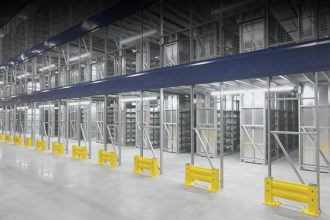Should A Damaged Rack Component Be Repaired Or Replaced?

Rack may become damaged. With forklift drivers maneuvering through industrial steel storage rack aisles with heavy pallet loads of product, it’s not unusual for the rack to be on the receiving end of an impact. But after a damaged rack column, anchor plate, anchor, strut or beam is discovered, rack owners must decide between repairing the damaged component or replacing it with a new part. To help provide clarity on which direction to go, RMI publishes the recently updated Guideline for the Assessment and Repair or Replacement of Damaged Rack — Version 2.0.
This document is intended to provide guidance for owners and users of pallet rack systems to help them assess rack damage; record and report both damage and subsequent repairs; evaluate the damage and develop an engineered solution for repair or replacement; and install the repair or replacement solution. The guide recommends following the mandate of RMI’s ANSI MH16.1: Specification for the Design, Testing and Utilization of Industrial Steel Storage Racks, section 1.4.1, subpart (2), which states:
Regularly inspect for damage. If damage is found, immediately isolate the affected area. Have a storage rack design professional evaluate the damage, and unload, replace or repair if directed by the professional, any damaged columns, beams, or other structural components to restore the system to at least its original design capacity.
The reason is explained in RMI’s guide:
Industrial pallet rack systems are highly engineered, high performance structures that are often exposed to product loads more than ten times the weight of the pallet rack system itself. Each component should have been designed, tested, manufactured, and subjected to rigorous quality controls to assure that it will safely withstand those demands.
There are four different options for remediating the damage, according to RMI’s guide. These include:
1. Replace the damaged components with identical parts from the original equipment manufacturer (OEM), or a qualified, engineer-driven pallet rack repair company. Do not assume that replacing that component with another one that looks similar will be fine. Even though pallet rack is manufactured for adjustability and assembly into multiple configurations, the precise execution of a rack design and its subsequent construction results from carefully conducted engineering calculations. The calculations determine the specific storage configuration and capacity limits, ensuring the rack’s safety and stability in a given application. Therefore, swapping in a component that looks similar to the damaged piece may render an existing system unsafe.
For systems with the original design documentation that have not been modified or reconfigured, damaged components can normally be replaced with identical new components from the same manufacturer or a qualified, engineer-driven pallet rack repair company. The replacement part should match the original design configuration and construction with at least the same grade and thickness of the steel. Utilizing a duplicate part for this repair means the information on the load application and rack configuration (LARC) drawings does not need to be modified or updated.
2. Use a pre-engineered rack repair kit. This option is ideal for situations where it might be more economical to remove the damaged section of an upright and replace with a kit that is bolted or welded in place, then anchored to the floor. To ensure the safety of this type of repair, a qualified rack engineer should first evaluate the configuration and loading of the existing rack at the point where the damage occurred to verify that any loads imparted on the damaged component will be safely supported by the repair.
3. Straighten the bent component. This should only be done if the appropriate properties of the steel can be maintained in the repaired part, as determined by the supervising storage rack design engineer.
4. Field weld the component with steel reinforcement. If replacement or repair kits are not an option, a welded field repair can be performed to reinforce the weakened component. The welding must be overseen by a qualified rack engineer to ensure the work is performed in alignment with American Welding Society codes and standards.
To learn more about rack repair best practices, download RMI’s Guideline for the Assessment and Repair or Replacement of Damaged Rack — Volume 2.


